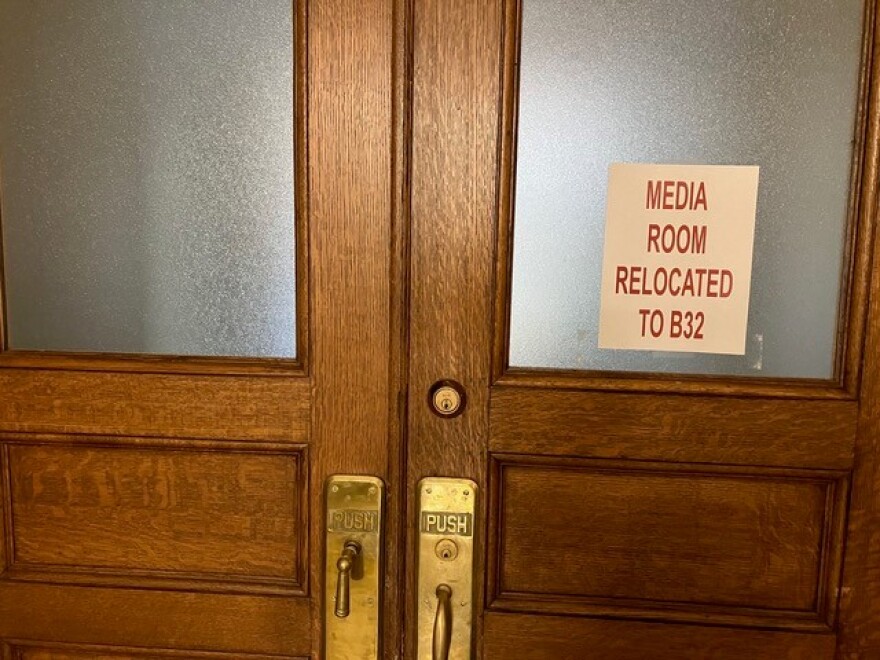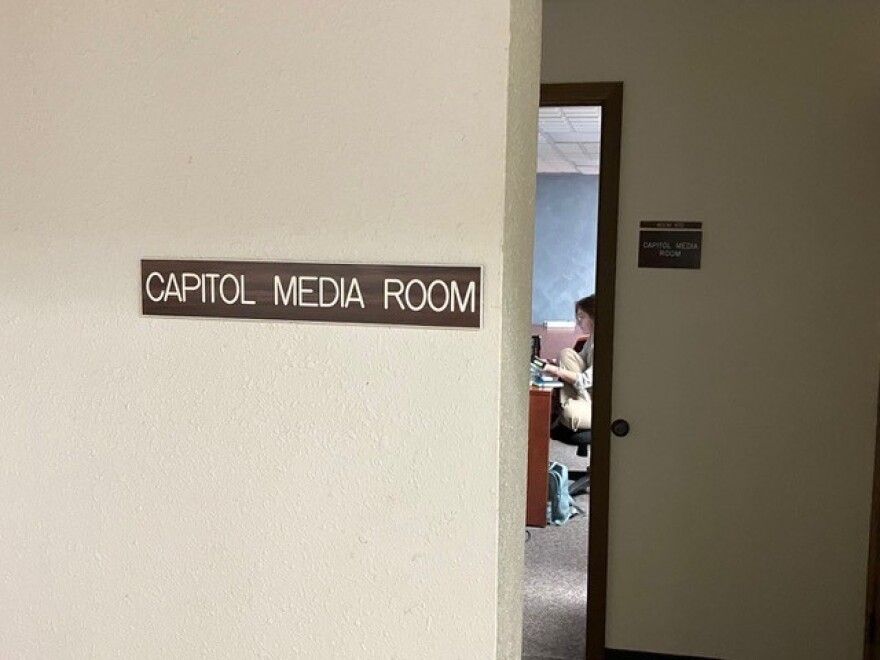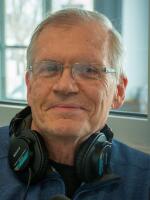I’ve been known to drive for five or six hours round trip to hunt pheasants for a couple of hours.
Tuesday I made a similar day trip to hunt for a story at the South Dakota Capitol.
My first stop in the Capitol after the metal-detector at the back door — “Phone, keys, wallet,” the security guard said as he held out a plastic tub — was the men’s restroom on first floor.
I’m 72, after all, and it had been an almost-three-hour drive to Pierre from Rapid City. So first things first.
I couldn’t estimate the number of times I’ve used that restroom over the years, especially during the years when I was covering the South Dakota Legislature for either the Sioux Falls Argus Leader or the Rapid City Journal.
But one past visit stood out clearly in memory on Tuesday, and I paused alone in the restroom to consider it.
It was during the 1995 legislative session. My brother, Terry, and I were both covering the legislative session for the Argus. And a few minutes earlier Terry had told me — I think while we were in or just outside of the first-floor press room around the staircase and across the hall from the restroom — that he had cancer.
I don’t recall my reaction. At least not my outer reaction. I’m pretty sure I know what my inner reaction was. Because cancer runs in our family. And my dad had died from it when I was 16. It was a short-but-ugly process. Dad’s cancer was in the stomach and liver, areas where treatment options in 1968 were mostly barbaric and ineffective.
But now he’s retired, living by the river and still writing columns
Terry’s cancer was in the prostate, which I would soon learn was much more treatable, especially when caught early.
The news, however, still sent me off to the first-floor restroom, to collect myself. Instead, I cried.
I wasn’t alone in there, at least not for long. Bob Mercer, then reporting from the capital for the Rapid City Journal, soon joined me, to quietly listen to my blubbering and my stated fears about my brother and his cancer. He didn’t say much. He didn’t have to. He stood there and offered support, for me and for my brother.
And Terry? He was a lot cooler about his own cancer than I was. At least on the outside. He went on to cover the rest of that Legislature, missing just the last day of session to begin preparations for surgery and head for Sioux Falls.
Twenty nine years ago, it was. And treatable, his cancer was. These days Terry and his wife, Nancy, are retired and living in a sweet little secluded house along the Missouri River in Chamberlain. He recently turned 80 and continues to write regular columns for the Mitchell Republic and the Tri-State Neighbor agricultural publication.
Bob Mercer, meanwhile, is still covering the news in the state capital, these days for Keloland News at keloland.com. And he is probably the only one left from the Capitol press corps back on that day when I stood weeping in the restroom who is still working full-time covering state government in Pierre.
That’s what took me to Pierre on Tuesday, to check in with Mercer and the rest of the downsized crew of news hounds still keeping tabs on things at the Capitol, especially during the annual legislation session.
Stopping at the old press room on first floor of the Capitol

Finished with my restroom recollections and other business, I walked around the staircase past the gift shop, where Dancing with Welk — a lyrical retelling of the Lawrence Welk story mixed in with a personal memoir by the ridiculously talented Christopher Vondracek — is prominently displayed. Pioneer Girl. the annotated autobiography of Laura Ingalls Wilder, was displayed next to Vondracek’s book.
I paused and almost perused. But this was no time to linger at the book shelf. On to the press room across the hall. Or what used to be the room, which is located down at the end of a short, dark hallway between lighted glass cases displaying miniature replicas of inaugural gowns worn by South Dakota first ladies — and a tux worn by one first gentleman —over the years.
That old press room was a drafty, funky place, right under the grand, outdoor staircase leading up to the front doors of the Capitol. It gave you a grounded feeling, as if you and the news reports you were filing were an essential part of the foundation of our society, as I believe they are.
The room had an odd configuration of main space, where the Associated Press, the Argus, the Journal and other news outlets had desks. Go farther back from the door and you could step down into separate two sort of cubby hole offices, with public radio on one side and a news service for small South Dakota newspapers on the other.
It could get loud and a little crazy in that room. But a lot of really good news work was done there by a lot of really good journalists. A lot of really good memories live there, too. I wish I could have opened the door to retrieve some more personally.
Even from the outside, however, I could recall a few, including working on what I believe was the last news story I wrote in that room. It was late afternoon on a mid-January day in 2012, and I was covering a memorial service in the Capitol for former Gov. Bill Janklow, who had died on Feb. 12th.
It’s not just “media;” it’s “news media"

I would travel on the next day to Sioux Falls for another memorial service, during which former Democratic U.S. Sen. Tom Daschle would eulogize Janklow as a loyal friend willing to cross party lines to get things done for South Dakota. Janklow’s son, Russell, would also say that his dad had lately been lamenting the divisiveness of politics at the time, so you could imagine what he would have thought about the environment today.
I don’t remember too much about writing my Rapid City Journal story on the Capitol service, other than that something went wrong with my laptop — or, more likely, with my operation of the laptop — and I struggled to get the story transmitted back to waiting editors in the Journal newsroom in Rapid City. Eventually, I think, I ended up dictating my story, which was a pretty comfortable process for me that probably seemed to some of the younger, computer savvy reporters like I had resorted to carrier pigeons.
I was thinking about all of that as I stood in front of the locked door with its dark windows and took a picture of the sign that read: “Media Room Relocated to B32.”
Just “media?” I know it’s just a temporary sign. But it’s “news media.” Come on.
Anyway, B32 is room 32 in the basement. It’s out of the way and unlikely to be found unless someone is searching for it or takes a wrong turn on the way to the basement cafe. It’s near what is called the nursing room, a private place where moms can go to breast feed or pump breast milk.
So, not exactly on the beaten path, which would be good for reporters working on deadline but maybe a bit isolating otherwise.
It’s a small room compared to the old press room. The press corps is smaller, too, of course, but not so much smaller that it didn’t get a bit claustrophobic, they tell me, early in the session when extra reporters were in the Capitol.
Finding the core of today’s Capitol press corps





When I found Room 32 on Tuesday, I also found a good share of today’s Capitol press corps. Annie Todd, a state political reporter for the Argus Leader, was there. So was former Argus reporter Jonathan Ellis, who joined fellow Argus reporter Joe Sneve to start the Dakota Scout, an independent newspaper in print and online.
Eventually they got permission to open the door to an adjoining room, when needed.
Soon we were joined in B32 by another Dakota Scout reporter, Austin Goss, and then by John Hult of South Dakota Searchlight, one of the two nonprofit news platforms now operating in South Dakota — the other being South Dakota News Watch.
And speaking of News Watch, not long after I stopped at Room 32 in the basement, I saw News Watch reporter Bart Pfankuch up in the third-floor lobby of the House of Representatives.
While I was wandering around upstairs, I stopped and checked in with well-known lobbyists Jeremiah Murphy of Rapid City and Tim Dougherty of Sioux Falls, whose fathers were iconic lobbyists in the Capitol, men I covered and respected. And while we chatted we were joined by public radio reporter Lee Strubinger, who is covering his eighth legislative session.
Down the hall in the press box on the floor of the state Senate, Strubinger’s public radio colleague CJ Keene was hard at work covering his first legislative session, in person, at least.
Not all legislative coverage is in person. There’s a lot you can do these days by internet to cover the session. And many reporters do. It saves time and expenses. But it’s not like being there, even if being there exposes you to the Capitol Crud, a pre-COVID, difficult-to-define ailment with multi-pronged symptoms that, in my days there at least, seemed to catch up with just about everyone eventually.
Covering 17 or 18 sessions is pretty good, but …
Now, of course, COVID is in the mix, too, although vaccines and treatments and generalized exposure have raised resistance levels in the general public and lowered the number of face masks you’ll see in the Capitol. And by lowered, almost eliminated. I guess I can’t remember seeing any masks there on Tuesday, but I might have missed or forgotten a few.
Brother Terry covered 40 legislative sessions and, as I like to say, lived to tell about it, something he does periodically in both spoken and written words.
This is Bob Mercer’s 36th session as a reporter. And he’s still at it.
I think I covered all or parts of 17 or 18 sessions, which is small-time stuff compared to Terry and Bob. Still, it gave me a pretty good sense of the place and the process. And it was fast-paced, often-challenging, mostly satisfying work that made me better as a reporter and a more informed citizen.
During my years in Pierre for sessions, I worked out of three different press rooms, starting in 1979. The first was on the fourth floor of the Capitol behind the House of Representatives. The Associated Press had been there for years, and print outlets joined them during session. UPI and broadcast outlets were in a similar space behind the Senate on the opposite side of the building.
It was a cramped space during session. But, boy, was that location good for pop-ins by legislators and access to the House and Senate.
A few years after that, we were moved to a decent-sized room in the basement, and the former press rooms on fourth floor were reconfigured for legislative purposes.
Important news stories and smart and colorful colleagues
The new space in the basement tended to get too warm and the flow of visitors was reduced. But it was near the door to the tunnel that goes under the front lawn of the Capitol and across the street to the Anderson and Foss buildings. That made for a nice indoor stroll when you had news business in those buildings and the weather was bad. They tell me the tunnel isn’t nearly as accessible these days.
After that second spot the press room was moved to the room under the front staircase. I worked in that room for about 10 sessions and went back for a day here and there after that, including to cover that Janklow memorial in 2012.
I stopped outside all three of those former press rooms during my Tuesday afternoon wanderings in the Capitol. Each one had memories. Each reminded me of important news stories, of smart and colorful colleagues, of intense deadline pressure and the emotional release that comes after you send your story off into the able hands of editors and, eventually, onto newsprint and computer screens.
It all reminded me, too, of the break I took from the mainstream news business for three years back in the ‘80s, to publish my own outdoor tabloid and work for South Dakota Tourism. TV newsman John Austin, an acerbic, highly intelligent guy with a sardonic sense of humor, also worked at tourism at that time during his own break from the news.
We liked the tourism work well enough. But it wasn’t news. Nothing else is. Or as Austin once said during our tourism days:
“Woost, what I miss most about the news business is the illusion of doing something that matters.”
Mostly, he was kidding, of course. All wry humor aside, Austin believed in the news business and its value, and he returned to it a couple of years later. He couldn’t help himself.
I returned to it, too, because I loved the work and because it’s essential to a free society. That’s true anywhere, but especially in places where government has the power to spend people’s money and change people’s lives, for better or for worse.
Places like the South Dakota Capitol, where you’ll find a news crew that is downsized in number, but still doing the people’s business.
And that matters to us all.


